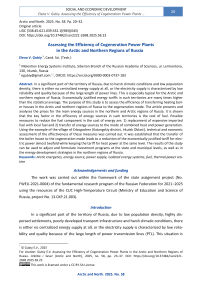Assessing the Efficiency of Cogeneration Power Plants in the Arctic and Northern Regions of Russia
Автор: Gubiy E.V.
Журнал: Arctic and North @arctic-and-north
Рубрика: Social and economic development
Статья в выпуске: 58, 2025 года.
Бесплатный доступ
In a significant part of the territory of Russia, due to harsh climatic conditions and low population density, there is either no centralized energy supply at all, or the electricity supply is characterized by low reliability and quality because of the large length of power lines. This is especially typical for the Arctic and northern regions of Russia. Economically justified energy tariffs in such territories are many times higher than the statistical average. The purpose of this study is to assess the efficiency of transferring heating boiler houses in the Arctic and northern regions of Russia to the cogeneration mode. The article presents and analyses the prices for the main energy sources in the northern and Arctic regions of Russia. It is shown that the key factor in the efficiency of energy sources in such territories is the cost of fuel. Possible measures to reduce the fuel component in the cost of energy are: 1) replacement of expensive imported fuel with local fuel and 2) transfer of energy sources to the mode of combined heat and power generation. Using the example of the village of Erbogachen (Katangskiy district, Irkutsk Oblast), technical and economic assessment of the effectiveness of these measures was carried out. It was established that the transfer of the boiler house to the cogeneration mode leads to a reduction of the economically justified tariff for electric power almost twofold while keeping the tariff for heat power at the same level. The results of the study can be used to adjust and formulate investment programs at the state and municipal levels, as well as in the energy development strategies in the northern regions of Russia.
Arctic energetics, energy source, power supply, isolated energy systems, fuel, thermal power station
Короткий адрес: https://sciup.org/148330873
IDR: 148330873 | УДК: [338.45:621.039:332.1](985)(045) | DOI: 10.37482/issn2221-2698.2025.58.23
Текст научной статьи Assessing the Efficiency of Cogeneration Power Plants in the Arctic and Northern Regions of Russia
DOI:
In a significant part of the territory of Russia, due to low population density, highly dispersed settlements, poorly developed transport infrastructure and harsh climatic conditions, there is either no centralized energy supply at all, or the electricity supply is characterized by low reliability and quality because of the large length of power transmission lines (PTL). This situation is especially typical for the northern part of the country, including the Arctic, which occupies 28% of Russia’s territory 1. In the area of decentralized power supply, autonomous power sources are used; as a rule, these are expensive to operate and environmentally unfavorable diesel power plants (DPP) [1, Sivtsev A.I., Sivtsev N.A., p. 1]. Centralized heat supply is provided by low- and medium-capacity boiler houses. In private houses, individual stove heating is used [2, Maisuk E.P., Ivanova I.Yu., p. 27]. A frequent problem for such areas is the untimely delivery of fuel.
Possible solutions to the above problems are:
-
• combined generation of electricity and heat at mini-heat and power plants (mini-CHPs) [3, Khokhlov A.];
-
• use of local types of fuel that do not require expensive transportation.
Cogeneration is more efficient than separate production of heat and electricity due to the reduction of total fuel consumption. In both separate and combined energy supply schemes, the cost of purchasing fuel prevails in the economically justified tariff for electric and thermal energy. Fuel saving from cogeneration is estimated at about 30%.
The purpose of this work is to assess the efficiency of transferring heating boilers in the Arctic and northern regions of Russia, where transport and energy infrastructure is underdeveloped, to cogeneration mode.
Research methods
In order to select the most cost-efficient energy supply option, it is common to use the lev-elized cost of energy (LCOE) indicator [4, Hansen K.; 5, Sheryazov S.K., Ptashkina-Girina O.S., Ni-zamutdinova N.S.; 6, Veselov F.V., Pankrushina T.G., Zolotova I.Yu.]. This indicator is increasingly used as the main tool for comparing economic assessments of energy projects. This indicator is the ratio of the sum of all costs (capital and current) during the project’s life cycle to the amount of energy produced over the entire life cycle. The levelized cost of energy reflects the energy tariff at which the investor is guaranteed break-even. This indicator is determined by the formula:
LCOE =
K=o(Ct + It) • (1 + r)-t K=o Et ■ (1 + r) -t where Ct — operating costs of the project per year t, million rubles; It — capital costs of the pro- ject per year t, million rubles; r — discount rate; Et — amount of electricity produced per year t, Gcal; t — life cycle of the technology, number of years.
When producing two or more types of energy in a single cycle, there is a problem of distributing costs between them. Taking into account the fact that the reduction in the amount of fuel used leads to a reduction in the tariff burden on consumers [7, Sukhareva E.V.], this problem is not only technical, but also an important social one [8, Beloborodov S.S.; 9, Biev A.A., p. 30]. The
SOCIAL AND ECONOMIC DEVELOPMENT
Elena V. Gubiy. Assessing the Efficiency of Cogeneration Power Plants … discussion on the distribution of costs between the production of electric and thermal energy at a combined heat and power plant (CHPP) has been going on for almost 100 years, since the IV AllUnion Heat Engineering Congress, held in 1928 as part of the I All-Union Energy Congress [10, Gorshkov A.S.].
There are many methods for distributing costs to solve the problem under consideration. All methods can be divided into two groups: those based on technological (or thermodynamic) principles and those based on economic principles. In the first group, the most well-known are physical, boiler, exergy, normative and proportional methods; in the second group — the shutdown method (Ginter triangle method), the method of cost reduction factors, the method of alternative energy production, the method of distributing savings and risks [11, Lyubimova N.G., Fomina V.N.].
In this paper, the shutdown method is used to assess the efficiency of combined production of electric and thermal energy. According to this method, it is assumed that under conditionally separate production of electric and thermal energy at a CHPP in the absence of heat supply, the CHPP will operate in the condensation mode of electricity production. This means that all costs will be related only to the production of electric energy. In this case, the economically justified tariff for electric energy will be maximum, and for thermal energy — zero. And vice versa: if the CHPP does not generate electrical energy, but only produces thermal energy from peak boilers, then all the costs of the CHPP will be fully attributed to the supply of thermal energy. In this case, the economically justified tariff for thermal energy is maximum, and for electrical energy is zero [12, Gitelman L.D., Ratnikov B.E.].
This method can be illustrated graphically using the so-called Ginter triangle (Fig. 1). The Ginter triangle is constructed by plotting the marginal values of economically justified tariffs for electrical and thermal energy at the CHPP and connecting the resulting points (A and B). With its help, it is possible to determine the values of economically justified tariffs for electricity and heat from CHPP for different modes.
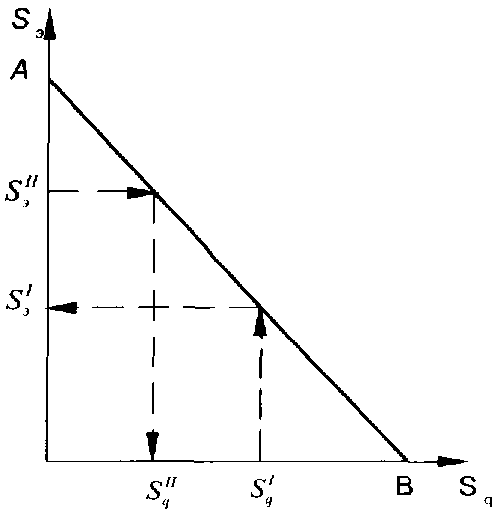
Fig. 1. Ginter triangle.
In the conditions of competitive markets of electric and thermal energy, the shutdown method allows comparing the values of tariffs for electric and thermal energy in combined and separate production. For example, if the economically justified tariff for thermal energy generated in a boiler house is known, then the shutdown method can be used to determine the economically justified tariff for electric energy at a CHPP while maintaining the specified tariff for thermal energy.
Fuel prices
In order to assess the cost indicators of fuel used in the northern regions of the Russian Federation, we collected and analyzed data on purchases from the official website of the Unified Information System in the Sphere of Purchases 2; responses to inquiries from relevant ministries and executive bodies of the relevant constituent entities in the field of state regulation of tariffs.
The prices presented below include not only the price of the energy source itself, but also its delivery, transloading and storage at all stages of transportation, VAT.
In most northern and Arctic settlements located in remote and hard-to-reach areas with underdeveloped energy infrastructure, the main type of fuel is diesel.
According to GOST 305–2013 3, diesel fuel must withstand the following temperature values:
-
• summer diesel fuel must be suitable for use at temperatures up to –5°C and above;
-
• winter diesel fuel is recommended for use up to –35°C and above;
-
• arctic diesel fuel — up to –45°C and above.
Therefore, only winter and arctic grades of fuel are used year-round in the study areas. Data on the cost of diesel fuel of these grades are presented in Table 1. The average price of diesel fuel in the study area is: winter fuel — 60–90 thousand rubles/t, arctic fuel — 63–142 thousand rubles/t. There is no data on the purchase of winter fuel for the purposes of electricity and heat supply in the Republic of Sakha (Yakutia), Magadan Oblast and Chukotka Autonomous Okrug (probably due to extremely severe climatic conditions in these constituent entities of the Russian Federation). The official website of the Unified Information System in the Sphere of Purchases does not contain information on the purchase of arctic diesel fuel for electricity and heat supply in the Republics of Karelia and Komi. The highest prices for diesel fuel are observed in the Arctic regions of the Arkhangelsk Oblast, Nenets Autonomous Okrug and Krasnoyarsk Krai.
-
Table 1
Winter and arctic diesel fuel prices in northern regions of Russia with poorly developed energy infrastructure in 2022
|
Subject of the Russian Federation |
Diesel fuel prices, thou. rub./t |
|
|
winter |
arctic |
|
|
Murmansk Oblast |
67–74 |
70–97 |
|
Republic of Karelia |
67–72 |
– |
|
Arkhangelsk Oblast |
63–71 |
66–116 |
|
Komi Republic |
62–75 |
– |
|
Nenets Autonomous Okrug |
64–72 |
67–154 |
|
Yamal-Nenets Autonomous Okrug |
61–90 |
67–94 |
|
Krasnoyarsk Krai |
60–73 |
65–142 |
|
Irkutsk Oblast |
67–80 |
85–114 |
|
Republic of Sakha (Yakutia) |
– |
63–98 |
|
Magadan Oblast |
– |
75–115 |
|
Chukotka Autonomous Okrug |
– |
87–91 |
Coal is one of the most common fuels for heat supply and is used almost everywhere in the northern and Arctic territories of Russia, especially in eastern Russia. The exception is hard-to-reach settlements of the Magadan Oblast and the Chukotka Autonomous Okrug, where coal delivery is logistically impractical. Detailed data on coal prices in the Arctic and northern regions of Russia are presented in Table 2. Of all the western regions of Russia, coal is mined only in the Komi Republic, which is the main source of supplies to the north-west of the country. From the Yamalo-Nenets Autonomous Okrug to the east, coal is mined in almost all regions of the country (Krasnoyarsk Krai, Irkutsk Oblast, Republic of Sakha (Yakutia), Magadan Oblast, Chukotka Autonomous Okrug). The high cost of coal in the northern and Arctic territories of these entities is mainly due to the complexity of transportation.
-
Table 2
Coal price in the northern regions of Russia with poorly developed energy infrastructure in 2022
|
Subject of the Russian Federation |
Coal price, thou. rub./t |
|
|
brown coal |
hard coal |
|
|
Murmansk Oblast |
8.5–8.8 |
9.5–66.4 |
|
Republic of Karelia |
7.8 |
8.1–9.9 |
|
Arkhangelsk Oblast |
– |
8.8–15.7 |
|
Komi Republic |
– |
7.3–14.7 |
|
Nenets Autonomous Okrug |
– |
27.1–43.3 |
|
Subject of the Russian Federation |
Coal price, thou. rub./t |
|
|
brown coal |
hard coal |
|
|
Yamal-Nenets Autonomous Okrug |
– |
9.4–10.1 |
|
Krasnoyarsk Krai |
3.3–12.0 |
23.4–63.7 |
|
Irkutsk Oblast |
3.1–12.0 |
3.2–12.2 |
|
Republic of Sakha (Yakutia) |
– |
4.0–23.0 |
|
Magadan Oblast |
– |
– |
|
Chukotka Autonomous Okrug |
30.1 |
– |
In the Arctic and northern regions of Russia, the main type of fuel for electricity generation is diesel fuel, and for heat production — coal. But other types of fuel are used along with them: liquefied petroleum gas (LPG), oil, fuel oil, and even wood fuel. Detailed data on the prices of these types of fuel in the territories under consideration are presented in Table 3.
-
Table 3
Prices for other types of fuel in the northern regions of Russia with poorly developed energy infrastructure in 2022
|
Subject of the Russian Federation |
Oil, thou. rub./t |
LPG, thou. rub./t |
Fuel wood, thou. rub./m3 |
Fuel pellets, thou. rub./t |
|
Murmansk Oblast |
– |
147 |
3.5 |
13.6–16.3 |
|
Republic of Karelia |
– |
29 |
2.8–4.2 |
– |
|
Arkhangelsk Oblast |
– |
33–73 |
2.4–5.0 |
11.8 |
|
Komi Republic |
– |
– |
– |
8.5–18.9 |
|
Nenets Autonomous Okrug |
– |
– |
17.3–18.2 |
– |
|
Yamal-Nenets Autonomous Okrug |
50.5–75.0 |
– |
– |
|
|
Krasnoyarsk Krai |
27.8–64.8 |
– |
– |
– |
|
Irkutsk Oblast |
80.0 |
– |
– |
– |
|
Republic of Sakha (Yakutia) |
64.1 |
24–45 |
– |
– |
|
Magadan Oblast |
– |
– |
– |
– |
|
Chukotka Autonomous Okrug |
– |
– |
– |
– |
Crude oil is rarely used for heat and electricity supply, mainly in production areas: Yamalo-Nenets Autonomous Okrug, Krasnoyarsk Krai, Irkutsk Oblast, and the Republic of Sakha (Yakutia). Its cost varies from 30 to 80 thousand rubles/t and depends on the distance and complexity of transportation.
In a number of subjects of the Russian Federation, autonomous gas supply is carried out. LPG is supplied to settlements of the Murmansk and Arkhangelsk Oblasts, the Republics of Karelia and Sakha (Yakutia). The cost of local LPG in the Republic of Karelia, the Arkhangelsk Oblast and the Republic of Sakha (Yakutia) varies from 24 to 73 thousand rubles/t depending on the transport component of the cost. The cost of LPG in the north of the Murmansk Oblast in 2022 was 147 thousand rubles/t (deliveries from the Komi Republic).
In the eastern regions of Russia, biofuel (represented by firewood, fuel chips and fuel pellets) is rarely used for heat supply in boiler houses. At the same time, in the Northwestern Federal Okrug (primarily in the Republics of Komi and Karelia, in the Arkhangelsk Oblast), there are state programs for modernization of small and medium-capacity boiler houses and their conversion to biofuel.
The analysis of Tables 1–3 showed that for all the territories under consideration, the highest fuel prices are observed in the Arctic. Prices for local types of fuel are significantly lower than for imported ones.
Current power supply of the village of Erbogachen, Katangskiy district, Irkutsk Oblast
The efficiency of cogeneration plants operating on local fuels in the Arctic and northern regions of Russia was assessed on the example of the village of Erbogachen, Katangskiy district, Irkutsk Oblast. The climate of the territory under consideration is characterized by sharply pronounced continentality, which is manifested in very low winter and high summer air temperatures, as well as in large differences between day and night temperatures. The absolute amplitude of air temperature reaches 100°C (absolute minimum — -61.2°C, absolute maximum: +38.8°C) 4. The duration of the period with an average daily air temperature of ≤0 °C is 213 days 5.
Erbogachen village is located in the decentralized power supply zone. Currently, electricity is supplied by 5 autonomous diesel power plant units. The total installed capacity of the diesel power plant is 3.5 MW, the average annual electricity generation is 9,548 MWh.
Over the past few years, the village of Erbogachen, Katangskiy district, has been experiencing regular disruptions in electricity supply. From October 10 to December 31, 2022, as a result of an accident, there was a restriction on electricity supply for the entire population of up to 7 kW per household. The reasons were the lack of operating capacity and the pre-emergency state of the DPP. Lack of fuel is a frequent problem due to poor transport infrastructure and seasonality of importation.
The required gross revenue for the electricity supply to consumers in the Erbogachen village in 2022 amounted to 471.2 million rubles. As can be seen from Fig. 2, the main expense item is the purchase of diesel fuel (87%). The economically justified tariff was 54.83 rubles/kWh, the standardized cost of electricity was 56.2 rubles/kWh.
Raw materials, basic supplies, %
Other expenses, 1%
Depreciation of fixed assets, 1%
Lease of
Labour remuneration,
Fuel, 87%
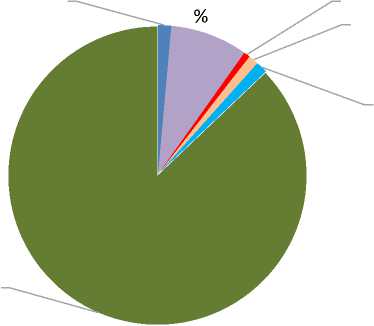
electric grid facilities, 1%
Fig. 2. The main expense items for electricity supply in the village of Erbogachen in 2022 6.
A boiler house with an installed capacity of 3.5 Gcal/h operates in the village of Erbogachen to provide heat and water supply for the population and social institutions. The average annual heat consumption in the settlement is 5,939.51 Gcal. Crude oil is used as fuel in the amount of 800 tons/year, supplied from a local oil and gas field.
The required gross revenue for heat supply to consumers in the Erbogachen village in 2022 amounted to 57.9 million rubles. As can be seen from Fig. 3, the main expense item is the purchase of fuel (61%). The economically justified tariff is 14,607 rubles/Gcal, the standardized cost of thermal energy is 16,534 rubles/Gcal.
Raw materials, basic supplies, %
Fuel, 61%
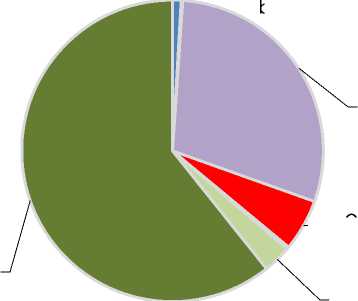
Labour remuneration, 29%
Other expenses, 6%
Electricity, 3%
Fig. 3. The main expense items for heat and water supply in the village of Erbogachen 7.
Table 4 summarizes all the initial data on the existing scheme of electricity and heat supply in the village of Erbogachen for further calculations.
-
Table 4
Initial data on the existing scheme of electricity and heat supply in the village of Erbogachen
|
Indicator |
Electrical energy |
Heat energy |
|
Capacity, MW/Gcal/h |
3.5 |
3.5 |
|
Output, MWh/Gcal |
9 548 |
7 425 |
|
Fuel type |
diesel fuel |
crude oil |
|
Fuel price, thou. rub./t |
114 |
80 |
|
Fuel consumption, tons/year |
3600 |
800 |
|
Economically justified tariff, rub./kWh/rub./Gcal |
56.2 |
16 534 |
Fuel for the DPP is delivered by a complex transport scheme. Since cargo is delivered to the Katangskiy district by winter road, there are often supply disruptions and fuel shortages. Oil for the boiler house is supplied from the Verkhnechonskoe oil and gas field, which is one of the largest in Eastern Siberia. Its recoverable reserves of ABC1 and C2 categories are estimated at 201.6 million tons of oil. Currently, Verkhnechonskneftegaz OJSC supplies about 800 tons of oil per year.
Based on the above, it seems reasonable to conduct a study to assess the efficiency of replacing separate production of heat and electricity with cogeneration of the same amount of these types of energy using oil.
In order to adequately compare separate and combined heat and electricity generation, it is proposed to compare the costs of the following energy supply options:
-
• existing separate energy supply scheme;
-
• separate power supply scheme when replacing existing DPPs with new diesel generator units (DGU) fueled by crude oil;
-
• combined production of electricity and heat at the CHPP, fueled by oil.
Assessment of the efficiency of separate generation with replacement of the existing DPPs
A classic diesel generator cannot use crude oil as fuel. A conventional internal combustion engine is designed in such a way that it requires fuel with certain parameters for normal operation of all components. Therefore, the consideration is not to replace the fuel in the existing diesel power plants, but to replace them with oil-fueled DGUs.
Power plants running on oil and fuel oil require mandatory preliminary fuel preparation. To ensure this, a fuel preparation container is provided in the system, the main task of which is to ensure the purification of fuel from water and mechanical impurities and its supply to the circulation modules.
It is planned to replace five existing DPPs with three DGUs with a nominal capacity of 1.25 MW. When replacing the DPP, capital expenditures will amount to 270 million rubles, of which: assembled DGU — 97.2 million rubles; fuel preparation units — 82.8 million rubles, transportation services and construction and installation work — 90 million rubles. The required gross revenue will amount to 295.0 million rubles per year. Its main components are shown in Fig. 4. Compared with the existing scheme, fuel purchase costs will decrease by 76.1 million rubles per year; depre- ciation charges will increase by 8.3 rubles million per year; tax deductions will increase by 1.4 million rubles per year. Thus, when replacing the existing DPPs in the village of Erbogachen with new DGUs running on crude oil, the economically justified tariff will decrease by 20.5 rubles/kWh and will amount to 34.33 rubles/kWh. The standardized cost of electricity in this case will decrease by 16.81 rubles/kWh and will amount to 39.36 rubles/kWh.
Raw materials, basic supplies, %
Labour remuneration, 13%
Other expenses, 1%
Depreciation of fixed assets, 5%
Lease of electric grid facilities, 2%
Fuel, 76%
Fig. 4. Main items of expenditure on electricity supply in the village of Erbogachen when replacing DPPs with new oil-fueled DGUs 8.
Assessment of the efficiency of combined generation
Based on the electric and thermal capacities of existing energy sources in the village of Erbogachen and the existing equipment for mini-CHPs on the market, it is proposed to build a cogeneration source with an installed electric capacity of 0.5 MW and an installed thermal capacity of 3.5 Gcal/h. In this case, it is assumed that a DGU with an installed capacity of 1.25 MW will operate simultaneously. The fuel used in the DGU is crude oil.
For effective and economical operation of the entire mini-CHP, two DE-4-14-225GM-O steam boilers with a total installed capacity of 3.5 Gcal/h and two TGU-500K block steam turbogenerator units were chosen. The turbine parameters were selected in strict accordance with the generator capacity, steam temperature from the steam boiler and pressure. It is assumed that the CHPP is located in the existing boiler house and all its systems of electricity, water, heat and fuel supply are used. This mini-CHPP will fully provide the village of Erbogachen with thermal energy for heat and water supply of the population and social institutions. To provide the village of Erbo-gachen with electricity, it is assumed that a diesel generator with a nominal capacity of 1.25 MW will additionally operate. To ensure the reliability of power supply in case of emergencies, existing DPPs can be used.
Data on the volumes of electricity and heat generation at the mini-CHPP by months are presented in Table 5.
Table 5
Volumes of electricity and heat generation at the mini-CHPP by months
|
Type of energy |
Month |
Year |
|||||||||||
|
1 |
2 |
3 |
4 |
5 |
6 |
7 |
8 |
9 |
10 |
11 |
12 |
||
|
Heat energy, Gcal |
1037 |
880 |
841 |
712 |
532 |
146 |
168 |
187 |
528 |
697 |
974 |
1021 |
7722 |
|
CHPP electricity, MWh |
372 |
336 |
372 |
360 |
372 |
298 |
351 |
380 |
360 |
372 |
360 |
372 |
4305 |
|
DGU electricity, MWh |
808 |
769 |
671 |
405 |
291 |
0 |
0 |
0 |
252 |
413 |
771 |
863 |
5243 |
|
Total electricity generation, MWh |
1180 |
1105 |
1043 |
765 |
663 |
298 |
351 |
380 |
612 |
785 |
1131 |
1235 |
9548 |
When replacing the existing DPP with a mini-CHPP and a diesel generator running on oil, capital expenditures will amount to 179.3 million rubles, of which: mini-CHPP — 89.3 million rubles; assembled DGU — 90.0 million rubles. The required gross revenue will amount to 338.7 million rubles per year, its main components are shown in Fig. 5.
Raw materials, basic supplies, %
Labour remuneration,
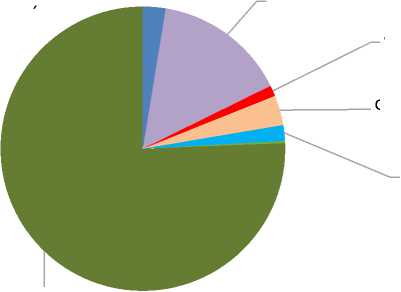
Lease of electric grid facilities, 2%
Fuel, 76%
Fig. 5. Main items of expenditure on electricity supply in the village of Erbogachen when replacing DPPs with mini-CHPs 9.
15% Other expenses, 1%
Depreciation of fixed assets, 3%
The shutdown method was used to allocate the CHP costs to electric and thermal energy. With the existing heat generation costs, the economically justified tariff for electricity from the CHP is 25.28 rubles/kWh, the standardized cost of electricity is 28.63 rubles/kWh. Compared with the existing energy supply scheme, the economically justified tariff for electricity will decrease by 29.55 rubles/kWh due to a decrease in total fuel costs by 188.5 million rubles per year.
Discussion of results
The key component in the economically justified tariff for both heat and electrical energy is the cost of fuel. Since in the Arctic and northern regions of Russia the cost of fuel increases significantly due to the high cost of transportation, it is necessary to look for ways to reduce the fuel
-
9 Source: author's estimations .
SOCIAL AND ECONOMIC DEVELOPMENT
Elena V. Gubiy. Assessing the Efficiency of Cogeneration Power Plants … component in the cost of energy of both types. This can be achieved by increasing the efficiency of power plants and using local types of fuel (especially since huge hydrocarbon reserves are concentrated in the north of Russia).
Three options of energy supply isolated from the unified energy system in the village of Erbogachen, located in the north of Irkutsk Oblast, were compared:
-
• existing energy supply scheme;
-
• separate generation, in which thermal energy is still generated by a boiler house running on local oil, and electricity is generated from new DGUs, also running on local oil;
-
• combined generation of heat and electric power by burning local fuel (oil).
The results of the study are presented in Table. 6. It has been established that at a fixed economically justified tariff for thermal energy, the highest economically justified tariff is typical for electric energy generated by an existing DPP operating on imported diesel fuel. Replacing an existing DPP with a DGU operating on local oil would reduce the economically justified tariff by 20.5 rubles/kWh. Introduction of mini-CHP with simultaneous operation of oil-fueled DGU would reduce the economically justified tariff for electricity by 26.55 rubles/kWh compared to the existing scheme.
Table 6
Economic indicators of energy production
|
Energy supply method |
Indicator |
Electricity, rub./kWh |
Heat energy, rub./Gcal |
|
Existing energy supply scheme |
Economically justified tariff |
54.83 |
14 607 |
|
Standardized cost |
56.18 |
16 534 |
|
|
Separate generation on oil |
Economically justified tariff |
34.33 |
14 607 |
|
Standardized cost |
39.36 |
16 534 |
|
|
Cogeneration on oil |
Economically justified tariff |
28.28 |
14 607 |
|
Standardized cost |
28.63 |
16 534 |
Conclusion
The possibility of cogeneration of heat and electricity is one of the promising directions in the electric power industry, an important way to improve energy efficiency and reduce harmful emissions through fuel saving.
A study of fuel prices in the Arctic and northern regions of Russia has shown that the highest prices are observed in the eastern Arctic, especially in areas extremely remote from major transport routes. Due to the transport component, prices for local fuels are always significantly lower than for imported ones. Therefore, in the Arctic and northern regions of Russia, rich in such minerals as coal, oil and natural gas [13, Kovalenko M.S., Sibileva E.V.], it is simply necessary to use them instead of expensive imported fuel [14, Morgunova M., Kovalenko A., p. 42]. Another way to reduce fuel costs can be the use of wood waste for energy purposes, as it is done in the Republic of Karelia, the Komi Republic, the Arkhangelsk and Murmansk Oblasts.
The example of the village of Erbogachen in the Katangskiy district of the Irkutsk Oblast shows that the key factor of energy source efficiency in remote hard-to-reach areas is the cost of fuel. The assessments demonstrate that the conversion of existing energy sources to local fuels is cost-effective. Even greater economic effect can be achieved by transferring these energy sources into cogeneration mode. The value of the economically justified tariff for electric energy after such conversion is reduced by almost half.

